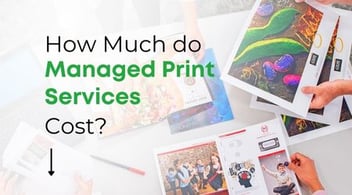MSPs: How Your Clients Can Renegotiate MPS Contracts
.jpg?width=960&height=323&name=How%20to%20Renegotiate%20Your%20MPS%20Contract_Web%20Banner%20(1).jpg)
Managed print services (MPS) contracts can be a tricky topic for your clients to navigate.
MPS contracts are agreements between client businesses and print vendors that outline the details of the maintenance and management of their printing equipment. These contracts often include equipment leases, supplies, and service agreements.
When one of your clients signs a contract with their print vendor, they are entering into a binding agreement lasting anywhere from three to five years.
That's a long time! Over the span of five years, it's not uncommon for a business to undergo radical restructuring, and their print needs are often significantly different at the end of the contract than they were in the beginning.
In many industries, the only constant is change.
Because of the ever-changing nature of many businesses, it is often beneficial for clients to review and renegotiate the terms of the MPS contract.
Print Partner works with the clients of MSPs across the US and Canada, supporting companies large and small with managed print services. After years of service, we know exactly what to look for in print agreements and when there may be room for adjusting certain rates or terms in a contract.
This article will discuss how your clients can renegotiate their MPS contracts, including the steps to take, the information to gather, and the considerations to make.
Step 1: Assess the Current Print Contract
Before renegotiating anything, your client should thoroughly assess their current MPS contract.
This includes reviewing the terms and conditions of the contract, the length of the contract, the equipment lease (One dollar buyout at the end of the term?), and the terms of the service agreement.
Your client should also understand their current usage to compare against what they are getting billed for. If they spend $500 per month for 10,000 mono pages and 1,000 color pages, but they are consistently only printing 5,000 and 100 color pages, this is a clear sign they should renegotiate. They are likely overpaying for print they don’t need.
Most contemporary printers can generate this report, or a utility like a PrintFleet agent will track this data across an entire fleet of printers.
This information will help your customer determine what changes need to be made to the contract.
But evaluating a current MPS contract can be intimidating. As with many contracts, MPS contracts have their fair share of jargon. And even if your client understood the agreement when it was initially created and signed, that doesn’t mean they remember all the details and fine print.
And if there were changes in leadership, this might even be your client’s first time looking at this document!
If your client struggles with reviewing their contract but feels that their printing needs are not being met, they should sit down with an industry professional to look it over.
Here are the primary pieces of the MPS contract to review:
- Cost: Discuss the costs of equipment leasing, supplies, click counts, and service agreements. They can use their industry research and the information they gathered from other vendors to reach a reasonable compromise on a pricing model that makes sense for both parties.
- Service level agreement (SLA): The SLA goes over the details of your client’s service suite, such as response time, repair time, and the availability of service technicians.
- Equipment: The equipment covered by the contract is another important consideration, which includes the types of equipment, the age of the equipment, and the terms of the equipment lease. They must negotiate favorable terms for their business that will meet future printing needs.
- Length of contract: The length of the contract is also an important consideration. Negotiating an agreement long enough to provide value for their business but not so long that they are locked into a contract that no longer meets their needs is vital.
While we aren’t the only ones, our team at Green Office Partner offers free MPS assessments if your client wants a second opinion on whether or not they’re getting a good deal.
It’s part of our Print Assessment process. To learn more, read: What is a Print Assessment?
Step 2: Gather Information About Printing Needs
Next, your clients should conduct internal research on their current printing needs.
Here are some areas they should consider:
- How many pages do they print per month in mono? In color?
- What size of pages are they printing on?
- What types of paper are they using?
- What business-critical applications do they use that depend heavily on print?
In addition, clients must consider any organizational changes that have occurred since the inception of their print contract. Any of the following can impact their printing needs:
- Additional locations or locations closing
- Change of in-office employee count
- Adjustment of service suite or business model
- Plans for major changes
Once this information has been gathered, the client will have a pretty good idea of whether or not their printing needs have drastically changed since the vendor wrote their MPS contract.
If they find that significant changes have been made, it’s probably time to renegotiate the contract terms. And having more information will help them negotiate more favorable conditions for their MPS contract.
Step 3: Research Other Vendors
The grass may indeed be greener on the other side.
If your client is unsatisfied with their current print agreement, encourage them to research other vendors and their MPS offerings.
This will give them a better understanding of the market and the options available to them. Competitor research can lead your client in two different directions, and either will benefit them:
- Market research will give them leverage in negotiating with their current MPS provider and pressure them into giving the client a better deal than their current plan.
- Your client will find another MPS provider better suited to their business needs.
Keep in mind that if your client is planning to switch providers, they need to understand the terms and conditions of their current agreement.
Most print agreements are ironclad, and the only way to get out of a deal early is if the contract is “bought out” - meaning, the total sum of the contract is paid in full..
Print vendors may offer to buy out a competitor’s MPS agreement if it makes financial sense, but this usually only happens if there are less than six months left on the contract.
Step 4: Prepare a New MPS Proposal
Once your client has researched the details of their contract and what other vendors in the industry offer, it’s time to make the vendor an offer they can’t refuse!
They need to prepare a proposal for renegotiating their MPS contract. This proposal should include the changes the client would like to make to the contract, the reasons for those changes, and any additional information that may be relevant in supporting the request.
They need to clearly communicate the changes their business has gone through - if the MPS provider wants to keep them as clients, they should sympathize with them and accommodate their needs.
Step 5: Negotiate With MPS Provider
Some back and forth is likely to occur, so your client should prepare to negotiate on pricing and the service package.
Negotiation can occur over phone calls and emails, but we highly recommend your client has the initial meeting in person.
The client must back up their proposal with facts and industry comparisons during the negotiation. They also need to prepare to compromise on specific terms to reach a mutually beneficial agreement.
Most things within the print agreement are locked in once documents are signed and finalized. But bringing up contract elements like cost and the terms of the SLA can open the door to potential revisions.
Ultimately, making changes to a signed, finalized contract is not always possible.but it’s always essential for the client to be honest and open with their print vendor. Airing grievances can pave the way for
Print Partner and MPS Contract Reviews
Hopefully, these tips will help your clients assess their current print contract, research print industry standards, and negotiate for more favorable terms. With your newly-acquired knowledge, you can go on and help your clients get the most from their print.
Renegotiating an MPS contract can be a daunting task. But luckily, your client doesn’t have to do it on their own.
Print Partner is the trusted MPS provider for MSP’s clients throughout the US and Canada. We’re proud to have cultivated relationships between hundreds of MSPs and our parent company, Green Office Partner, which delivers top-shelf, white-gloved print services to our MSP partners’ clients.
We offer value in three ways to our MSP partners:
- Collaboration: When print devices malfunction, we communicate directly with our clients’ service providers to find a quick solution.
- Protection: It’s no secret that many print providers are creeping into the IT space with slapped-on MSP-related services. We don’t offer IT services (never will), and we’ll protect your hard-earned clients from other print vendors.
- We’ll pay you for referrals! For each deal we close, we’ll pay the person who registers the opportunity at least $500 for the introduction and an additional $250 per $25K in revenue the deal brings us. For the MSP, we’ll pay $1,000 per 11x17 MFP sold, $100 per printer sold, and 5% recurring revenue on the client’s print allotment. And we’ll provide exceptional client service while we’re at it.
So, if you find a client dissatisfied with their current print agreement, send them our way, and we’ll ensure they’re getting everything they need out of their MPS.
Consider partnering with us, a Print Partner you can trust.



